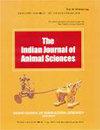乌吉尔省兽医诊所奶牛农用化学品中毒的调查研究
IF 0.3
4区 农林科学
Q4 AGRICULTURE, DAIRY & ANIMAL SCIENCE
引用次数: 0
摘要
鉴于印度没有关于牲畜农药中毒的数据,开展本工作的目的是在5年期间研究牛农药中毒的流行病学方面。2016-2020年,乌吉尔兽医与动物科学学院兽医临床综合中心共报告了98例牛农药中毒病例,医院患病率为0.39%。各类农用化学品中,杀虫剂中毒占45.91%,杀菌剂中毒占17.34%,除草剂中毒占16.32%,不明农药中毒占10.20%,化肥中毒占7.14%,杀鼠剂中毒占3.06%。2016年报告的中毒病例数最高(30.61%),其次是2017年、2019年(19.38%)和2018年(18.36%),11月(14.28%)、12月(13.26%)、7月和9月、10月(11.22%)报告的中毒病例数最高。季风季节和后季风季节中毒发生率最高,夏季最低。按年龄划分,农药中毒发生率最高的是4-6岁和0-2岁年龄组的动物。从种类上看,中毒发生率最高的是牛(65.31%),其次是水牛(34.69%)。牛中雄性占67.18%,雌性占32.82%。所有被证实中毒的水牛均为雌性。本研究结果将有助于制定减少畜禽农药暴露的策略。本文章由计算机程序翻译,如有差异,请以英文原文为准。
Study on occurrence of agrochemical poisoning in Bovines at veterinary clinics of Udgir
In view of unavailability of data on agrochemical poisoning in livestock animals in India, the present work was conducted with objective to study the epidemiological aspects of agrochemical poisoning in bovines over a period of five years. A total of 98 cases of pesticide poisoning in bovines have been reported during 2016-2020 at Veterinary Clinical Complex, College of Veterinary and Animal Sciences, Udgir with hospital prevalence of 0.39%. Among various agrochemicals, insecticide poisoning was responsible for 45.91% cases, fungicide for 17.34%, herbicides for 16.32%, unknown pesticides for 10.20%, fertilizers for 7.14% and rodenticides for 3.06% cases of poisoning in bovines. Year-wise higher number of cases were reported during 2016 (30.61%) followed by 2017, 2019 (19.38% each) and 2018 (18.36%) while, month- wise highest number of poisoning cases were reported in months of November (14.28%), December (13.26%), July and September, October (11.22% each). Season-wise highest occurrence of poisoning was observed during monsoon and post-monsoon seasons while least occurrence was observed during summer season. Age-wise highest occurrence of agrochemical poisoning was reported in 4-6 year and 0-2 year age-group animals. Species-wise occurrence of poisoning revealed highest occurrence in cattle (65.31%) than buffaloes (34.69%). Among cattle 67.18% male animals while 32.82% female animals were affected. All buffaloes confirmed for poisoning were female. The findings of the present study will be helpful for formulating strategies to reduce exposure of livestock animals to agrochemicals.
求助全文
通过发布文献求助,成功后即可免费获取论文全文。
去求助
来源期刊

Indian Journal of Animal Sciences
农林科学-奶制品与动物科学
CiteScore
0.60
自引率
25.00%
发文量
220
审稿时长
8 months
期刊介绍:
Articles published in The Indian Journal of Animal Sciences encompass a broad range of research topics in animal health and production related to cattle, buffalo, sheep, goat, camel, equines, pig, rabbit, yak, mithun, poultry and fisheries. Studies involving wildlife species and laboratory animal species that address fundamental questions about their biology will also be considered for publication. All manuscripts must present some new development and must be original, timely, significant and scientifically excellent. Papers will be rejected if standards of care of, or procedures performed on animals are not up to those expected of humane veterinary scientists. At a minimum, standards must meet the International Guiding Principles for Biomedical Research involving Animals, as issued by the Council for International Organizations of Medical Sciences. (C.I.O.M.S., c/o WHO, CH 1211 Geneva 27, Switzerland). Articles reporting new animal disease must follow GOI directive as given in detail in Guidelines to Authors.
 求助内容:
求助内容: 应助结果提醒方式:
应助结果提醒方式:


